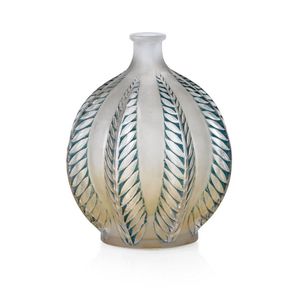Rene Lalique Malines Vase with Leaves and Enamel Highlights
You must be a subscriber, and be logged in to view price and dealer details.
Subscribe Now to view actual auction price for this item
When you subscribe, you have the option of setting the currency in which to display prices to $Au, $US, $NZ or Stg.
- Art Nouveau Period - The Art Nouveau period was a cultural movement that emerged in the late 19th century, and was characterized by its emphasis on natural forms, flowing lines, and a decorative, ornamental style. Art Nouveau was a reaction against the ornate and heavily stylized designs of the previous era, and sought to create a new, more organic aesthetic.
Art Nouveau was characterized by its use of sinuous, curving lines, as well as a focus on natural elements such as flowers, vines, and other organic shapes. Art Nouveau designers sought to create a total work of art, in which every element of a building or object was designed to be harmonious with the overall design.
Some of the most iconic examples of Art Nouveau design include the Paris Metro entrances designed by Hector Guimard, the works of the artist Alphonse Mucha, and the architecture of Victor Horta in Brussels.
The Art Nouveau period was at its peak between 1890 and 1910, but began to decline in popularity by the start of World War I. However, Art Nouveau remains an important influence on design and art to this day, and continues to be celebrated for its emphasis on natural forms and decorative style. - Art Deco Period - The Art Deco period was a cultural movement that emerged in the 1920s and 1930s, and was characterized by its emphasis on modernism, luxury, and elegance. The name "Art Deco" comes from the Exposition Internationale des Arts Décoratifs et Industriels Modernes, a large exhibition held in Paris in 1925 that showcased the latest trends in decorative arts.
Art Deco was a reaction against the ornate and elaborate styles of the previous era, and reflected a new modern sensibility. It was characterized by streamlined, geometric shapes, bright colours, and the use of new materials such as chrome, glass, and Bakelite. Art Deco designers sought to create a sense of luxury and sophistication, often incorporating expensive materials such as ivory, marble, and rare woods.
Art Deco had a significant impact on a wide range of artistic fields, including architecture, fashion, graphic design, and interior design. Some of the most iconic examples of Art Deco architecture include the Empire State Building in New York City, the Hoover Building in London, and the Palais de Chaillot in Paris.
The Art Deco period came to an end in the 1940s, as World War II and changing cultural trends led to a shift in artistic styles. However, Art Deco remains an important influence on design and art, and continues to be celebrated for its modernist sensibility and glamorous aesthetic.
This item has been included into following indexes:
- Art Nouveau - glass objects 165
-
Lalique (France), item types
- other items 1,103
- vases 562
- Lalique (France), patterns, vases - Malines 6
- Schneider / Le Verre Francais (France) - lamps and lighting 313
Visually similar items

Mirek Smisek. Branch pot, a large salt glazed branch pot with a manganese glaze and band of incised diagonal lines. Impressed mark. Height 51 cm. Diameter 36.5 cm

A Rene Lalique Espalion vase, designed 1927, the ovoid body moulded with overlapping fern leaves, in frosted and opalescent glass with a blue patina, inscribed R. Lalique France No. 996', 18 cm high. Provenance: Renee Antiques, New York, Mr Hans Mueller an

A Rene Lalique Aras vase, designed 1924, the ovoid body moulded with a scene depicting Macaws in flight and perched amongst foliage, in frosted and clear glass with remnant blue patina, moulded R. Lalique and inscribed France, 23 cm high. Provenance: Renee

A Rene Lalique Lievres vase, designed 1923, the compressed bottle shaped body moulded with leaping hares within foliate borders, in frosted and opalescent glass with a blue patina, inscribed R. Lalique France, 16 cm high. Provenance: Gallery 554, Melbourne
